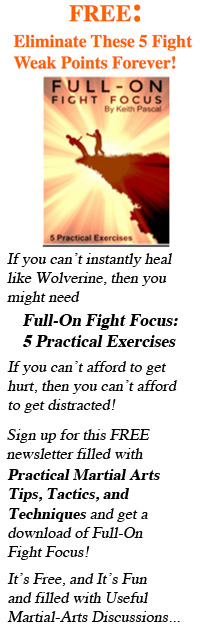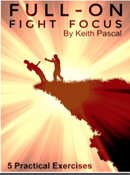Indirect Attack Precision with Multiple Attackers
Indirect Attack Precision with Multiple Attackers
by Keith Pascal
You’re walking along the street; you turn the corner, and … gulp … there are four evil-looking men. Before you can change direction, they orient on you, and go into attack mode.
Now, what?
In Martial Arts Mastery, we discussed “my” impossibility of running away. Maybe you can’t get away, either. So, “we” are going to have to face them.
I know what you’re thinking: It’s hard enough to get in on one attacker, let alone the two
that are about to reach me at the same time … with the others close behind.
Note: And so Miah finally gets his answer of why I sometimes feel that it’s easier to deal with multiple opponents instead of just one….
If two guys are about to reach me and I turn and face one, then I’m dealing with him while the other clobbers me. This is NOT good. But … if two guys are about to reach me, and I turn to face one, but hit the other, I have now improved my odds of being able to … deal with the other a-holes. There are more reasons, of course, but this is a good start.
This fake, or indirect attack, is what we’re going to work on today.
Why?
Because most people make pitiful attempts; this particular defense doesn’t work for them. So, let’s talk about the principle.
To make sure we’re on the same page, we’re discussing faking where you seem to deal with one attacker while you hit another. Got it?
The problem associated with this way of attack is twofold:
1. The fake-out seems obvious and doesn’t fool either attacker.
2. On the rare occasions where you do convince one attacker to defend, and you try to hit the other, you miss the second part of the attack completely.
The second guy isn’t where “he’s supposed to be.”
Does any of this look familiar? Or is this your first time considering multiple assailants?
Let’s take these snafus in order.
First, you have to convince one attacker that you’re counterattacking or meeting his initial approach with something mean and nasty. Right?
Not necessarily.
You have to convince him that “he’s going to be the first to deal with you,” but it
doesn’t have to be an attack.
Note: I’m taking the fake/feint of an attack out of the picture, because frankly, so many martial artists are terrible actors. They couldn’t fake an attack, if their lives depended on it.
And in this case, it just might. If you’re at a more advanced level, go ahead and practice your feints.
Don’t bother faking a full-on attack. Simply suggest that you’re focusing on one of the attackers and not the other. How do you do this?
* Use an eye fake. “Glance” toward the first guy.
* Start to turn your body, as though you’re focusing on the “dude.”
* Let your shoulder start to pivot toward the first ambusher.
* Change your hand position, as if you’re going to meet his attack first.
If you do any, or a combination, of these actions correctly, you’ll get a perceptible response. Maybe the first guy changes hand position to deal with you. Or the second guy could pause a little, to let the first guy hit or kick you.
There are other indicators, as well. You’ll see, hear, feel, or sense “something.”
And right as you perceive this is when you should be firing off your kick or strike at the secondary opponent.
Note: If you want to drop the meanest monster first, then make sure you fake toward the obvious subordinate. For me, I choose my attack order based on proximity. Enough said.
So, the first part of this equation says that you should develop mini-convincers to fake out the first attacker. Call them “little intents.”
The second problem has to do with looking toward the first guy. Since a glance at attacker number two would telegraph your intent, you have to hit “blind,” so to speak. You look at one, but hit number two.
I have three suggestions to improve your chances of making contact with that second “ogre”:
1. Learn to track. Predict where his head is moving and then hit where it’s going to be. Develop the timing to do this.
2. Practice a lot with moving targets. Training with a top-and-bottom bag might be a good idea.
3. Practice finding the opening with your peripheral vision. Out of the corner of your eye, decide whether you need to kick or hit.
Whew!
That was a “brain-full” for the morning. Enough to ponder, I hope.
Any questions?
Keith


